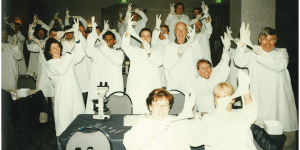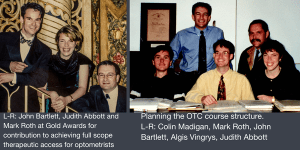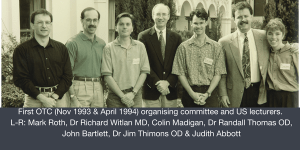1:30min

There are few who have changed the profession of Australian optometry more than John Bartlett. His diverse contributions span legislative changes, therapeutics scope of practice rights and educational innovations. John’s many achievements were recognised recently by OV/SA with a Life Member Award.
We caught up with John to delve into some of his many career highlights.
Congratulations John on the OV/SA Life Member Award! Of your many achievements in optometry, which would you describe as the most significant?
Having recently retired, I can now reflect on a fulfilling professional career including private practice, undergraduate and postgraduate teaching and finally, a senior leadership role with Essilor, where I led all customer-facing Education and Professional Services in countries throughout Asia Pacific, the Middle East, Russia and Africa.
My greatest memories, however, are the years from 1986 to 2001, when I was a councillor on the Victorian Division Council (now the OV/SA Board) including serving as President. This was an exciting time at the commencement of the Division’s effort to achieve therapeutic prescribing rights for Victorian optometrists.
I think my most significant contribution was establishing the education strategy to show the Victorian Government and health bureaucrats that practising optometrists were ready to progress from diagnosis of eye disease to full scope management of anterior eye disease. Central to this contribution was the significant expansion of the Southern Regional Congress (SRC) and the introduction of a comprehensive ocular therapeutics course (OTC) in collaboration with The State University of New York, USA. I was fortunate to work with a large and diverse team to achieve what most said could not be done – achieving full scope therapeutic prescribing rights for the management of anterior eye disease.

How did you achieve this?
Firstly, fellow councillors supported my proposals to aggressively change educational initiatives, to grow SRC to become one of the largest optometric conferences in the southern hemisphere by the mid-1990s, and for the Division to implement the OTC to support our arguments that the profession was well placed to take this step.
Secondly, I had an extraordinary education sub-committee including Mark Roth, Judith Abbott, Colin Madigan, Genevieve Napper and Sonja Gaulke. They worked tirelessly, and voluntarily, over 10+ years to achieve our outcomes. I established a strong partnership with the State University of New York, so we were able to secure many key US optometric educators as presenters at the SRC and OTC. This partnership concept was enhanced by sharing these educators with the Queensland University of Technology, reducing the significant costs of engaging them.
Finally, and pivotal to our success, was the enormous support from the profession. Attendance at SRC quickly grew such that 80% of all Victorian optometrists attended the 17th SRC in 2001, when it became one of the largest optometric congresses in the southern hemisphere. Around 140 optometrists attended one of the three OTCs delivered and participated in the intensive 80 hours of therapeutic education and assessment. All at a time before therapeutic legislation!

What do you consider to be the greatest challenges for our profession?
Perhaps the most critical issue is managing the perception of optometry within the broader consumer landscape. Changes including technology, AI and online shopping will continue to happen at an accelerated rate, altering the way consumers think about accessing any form of healthcare. I’m an informed eyecare/healthcare consumer, but I rarely see the clear value proposition, other than price, articulated from my position as a consumer. Our profession needs to be very agile and forward focused.
I also believe we need to expand the scope of practice. It’s now been 25 years since the significant leap into therapeutic practice. New Zealand, the UK and the US have advanced the scope of practice significantly. We must catch up, and this requires strong practitioner involvement.
Other challenges include addressing encouraging optometrists to work regionally, ensuring Medicare stays relevant to the changing face of health care, maintaining a thriving independent sector and encouraging participation in effective governance of the profession.
What advice do you have for early career optometrists?
Blink and you will be approaching retirement or considering a career move! So, get involved and participate in addressing the challenges I outlined above and the issues that resonate with you. Sometimes this means going outside your comfort zone, but it is well worth it and contributes immeasurably to outcomes for the profession and for yourself.
About John Bartlett
As a leader within the Victorian division of Optometry Australia (now OV/SA) for over 15 years, including serving as President from 1994 to 1996, John played a pivotal role in securing expanded therapeutic rights for optometrists. He was instrumental in developing therapeutic courses, in partnership with the Optometry Departments of the State University of New York and Queensland University of Technology, and advocating for government recognition of prior experience and learning. This enabled optometrists to gain full scope to prescribe topical S4 drugs, including glaucoma medications, without the need for lengthy full-time courses.
John was an optometry lecturer at the University of Melbourne for 13 years and director for the Southern Regional Congress (SRC). He transformed SRC into one of the largest ophthalmic conferences in the southern hemisphere, attracting renowned international speakers and focusing on cutting-edge topics.
In 2008, John left private practice to pursue his passion of delivering professional education, taking a global leadership role at Essilor. In this time, he oversaw the strategic direction of Essilor’s Professional Services and delivery of training programs to eyecare practitioner in countries throughout Asia Pacific, the Middle East, Russia and Africa.
Tagged as: History, life member, OV/SA Awards